Attached files
| file | filename |
|---|---|
| EX-99.1 - EX-99.1 - AMICUS THERAPEUTICS, INC. | a17-10316_1ex99d1.htm |
| 8-K - 8-K - AMICUS THERAPEUTICS, INC. | a17-10316_18k.htm |
Exhibit 99.2
Epidermolysis Bullosa Program April 2017
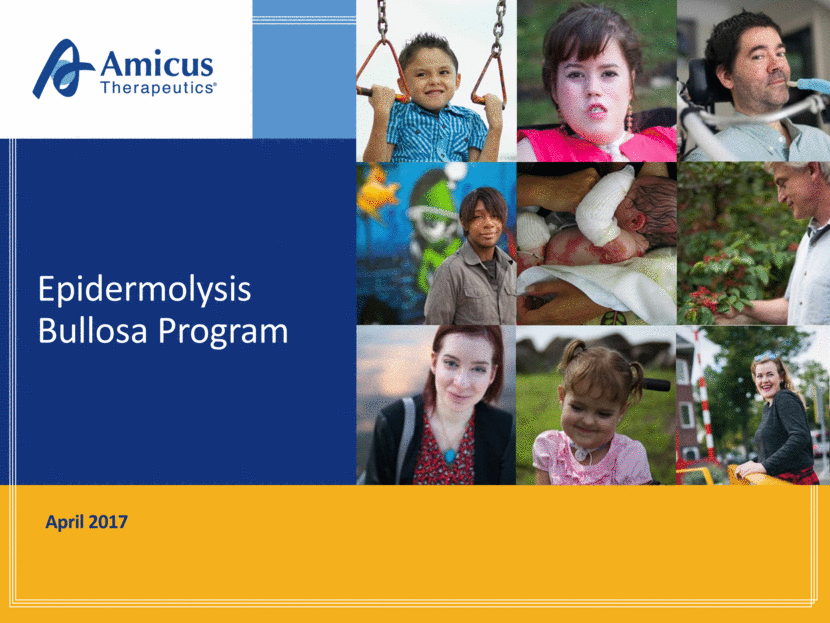
Safe Harbor Statement This presentation contains "forward-looking statements" within the meaning of the Private Securities Litigation Reform Act of 1995 relating to clinical development of our product candidate and the timing and reporting of results from our clinical trial. The inclusion of forward-looking statements should not be regarded as a representation by us that any of our plans will be achieved. Any or all of the forward-looking statements in this press release may turn out to be wrong and can be affected by inaccurate assumptions we might make or by known or unknown risks and uncertainties. For example, with respect to statements regarding the potential goals, progress, and timing of results of our clinical trial, actual results may differ materially from those set forth in this release due to the risks and uncertainties inherent in our business, including, without limitation: the potential that results of our clinical study indicates that the product candidate is unsafe or ineffective; the potential that regulatory authorities, including the FDA, EMA, and PMDA, may not grant or may delay approval for our product candidates; the potential that the clinical study could be delayed because we identify serious side effects or other safety issues; and the potential that we will need additional funding to complete our study. Further, the results of earlier preclinical studies and/or clinical trials may not be predictive of future results. In addition, all forward-looking statements are subject to other risks detailed in our Annual Report on Form 10-K for the year ended December 31, 2016. You are cautioned not to place undue reliance on these forward-looking statements, which speak only as of the date hereof. All forward-looking statements are qualified in their entirety by this cautionary statement, and we undertake no obligation to revise or update this presentation to reflect events or circumstances after the date hereof. Introduction
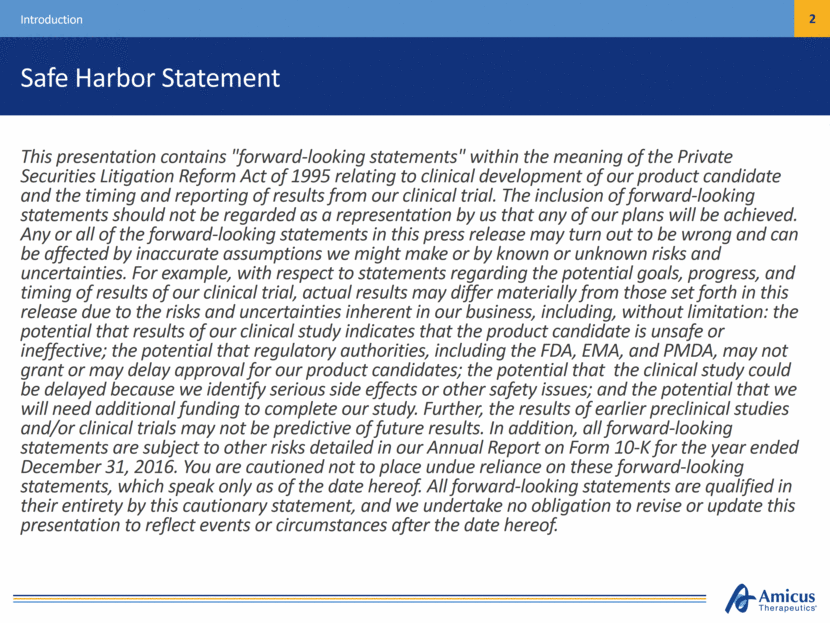
EB Program Overview
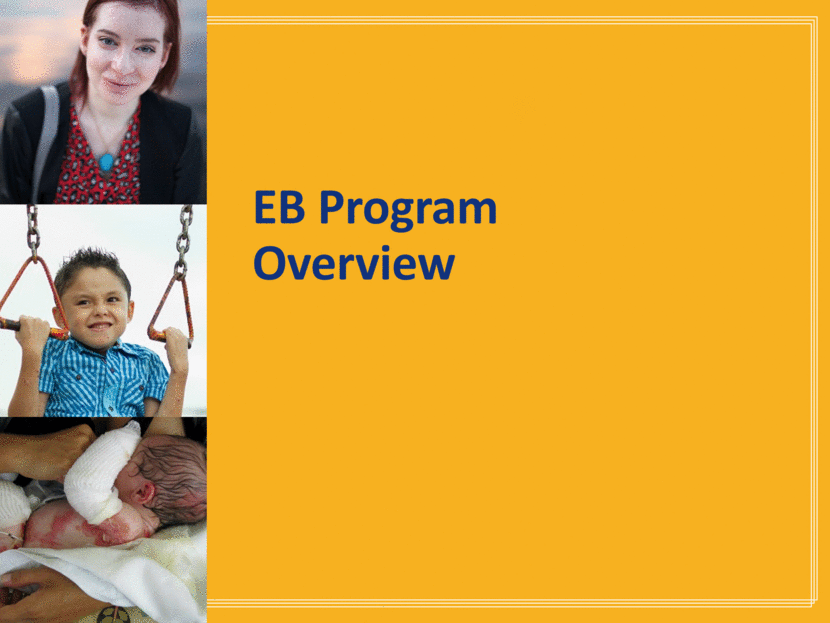
EB Disease Overview SD-101 for EB Rare, Devastating, Connective Tissue Disorder with No Approved Treatments Disease Overview Multiple genes cause disease Can affect internal organs Can be fatal Wounds can lead to life-threatening infections Diagnosis: infancy to adulthood Three Major EB Types (~99% of EB Population) SIMPLEX (75%) DYSTROPHIC (20%) JUNCTIONAL (5%)
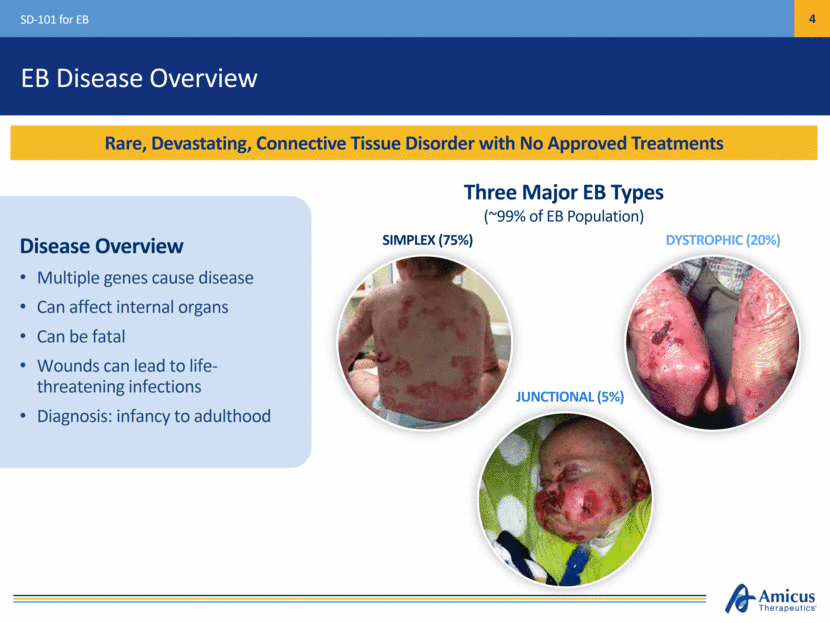
SD-101 – Patented High Concentration Allantoin SD-101 for EB Novel, Proprietary Topical Cream Promotes Healing of Wounds in EB and is Differentiated by Applicability for All Major EB Types Active ingredient Allantoin RoA Proprietary topical cream containing 6% allantoin, applied to entire body once daily Proposed indication All major EB types (Simplex, Dystrophic, and Junctional) Phase of development Phase 3 enrollment complete Potential Triple-Targeting MoA1-8 Anti-inflammatory, pro-collagen, anti-microbial Formulation Patented formula to deliver high concentration in highly stable, soluble form Araujo LU, et al. Acta Cirugica Brasileira 2010;25:460-466. Arajuo LU et al. Pharmazie. 2012;67:355-360. Frikeche J, et al. Archives of Dermatological Research. 2015;307:211-218. Haag SF, et al. Eur. J. Pharm. Biopharm. 2014;86:227-233. 2015;70:155-164. 5. Couteau C, et al. Arch Dermatol Res. 2012; 304:817-821. 6. Jorge MP, Madjarof C, Ruiz AL, et al. Journal of Ethnopharmacology. 2008;118:361-366. 7. Özçelik B, Kartal M, Orhan I. Pharmaceutical Biology. 2011;49:396-402. 8. Svetlichny G, et al Pharmazie. 2015;70:155-164.

Potential Mechanism of Action – Triple Targeting in Healing of Wounds SD-101 for EB Literature Describes 3 Main Mechanisms Contributing to Multi-Faceted Wound Healing Effects ⬇ inflammatory cell chemotaxis1,2 ⬇ inflammatory cells1,2 ⬇ dendritic cell activity3 ⬇ cytokine secretion3 ⬇ oxidative stress1,2,4 ⬇ edema5 ⬇ bacteria7 ⬇ fungi7,8 ⬇ viruses7 ⬆ collagen synthesis1,2,6 ⬆ collagen deposition1,2,6 Araujo LU, et al. Acta Cirugica Brasileira 2010;25:460-466. Arajuo LU et al. Pharmazie. 2012;67:355-360. Frikeche J, et al. Archives of Dermatological Research. 2015;307:211-218. Haag SF, et al. Eur. J. Pharm. Biopharm. 2014;86:227-233. 2015;70:155-164. 5. Couteau C, et al. Arch Dermatol Res. 2012; 304:817-821. 6. Jorge MP, Madjarof C, Ruiz AL, et al. Journal of Ethnopharmacology. 2008;118:361-366. 7. Özçelik B, Kartal M, Orhan I. Pharmaceutical Biology. 2011;49:396-402. 8. Svetlichny G, et al Pharmazie. 2015;70:155-164.

Proof of Concept Findings Phase 2 Results Informed Phase 3 Design SD-101 for EB Breakthrough Therapy Designation Phase 2a Key Takeaways (SD-101 3%) Faster time to wound closure Higher proportion with complete closure Reduction in total body surface area (BSA) of wounds Larger wounds (>10 cm2) showed widest separation versus placebo Daily administration generally safe and well-tolerated Informed Phase 3 Study Design Phase 2b Key Takeaways (SD-101 6%) 1-Year-Old Girl with EB Simplex at Baseline Following 2 months of treatment with SD-101
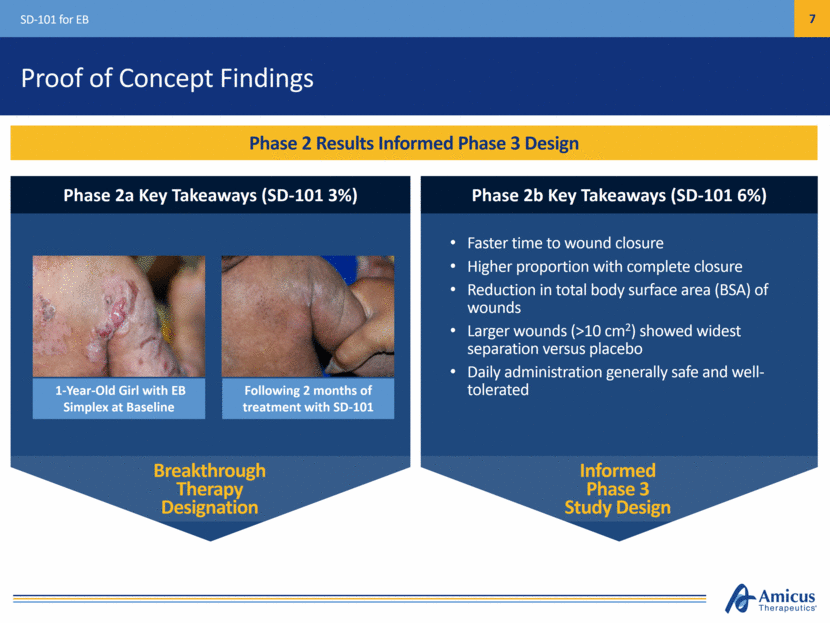
Phase 3 Study - Delivering on Our EB Vision Phase 3 Study Optimized for Success with Top-Line Data On Track for 3Q17 SD-101 for EB SD-005 Study Design Optimized 95%+ participation in extension study Study overenrolled (>160 patients) Top-line data anticipated 3Q17 Status Sample size of up to 150 patients Larger baseline target wound size Time to wound closure endpoint elevated
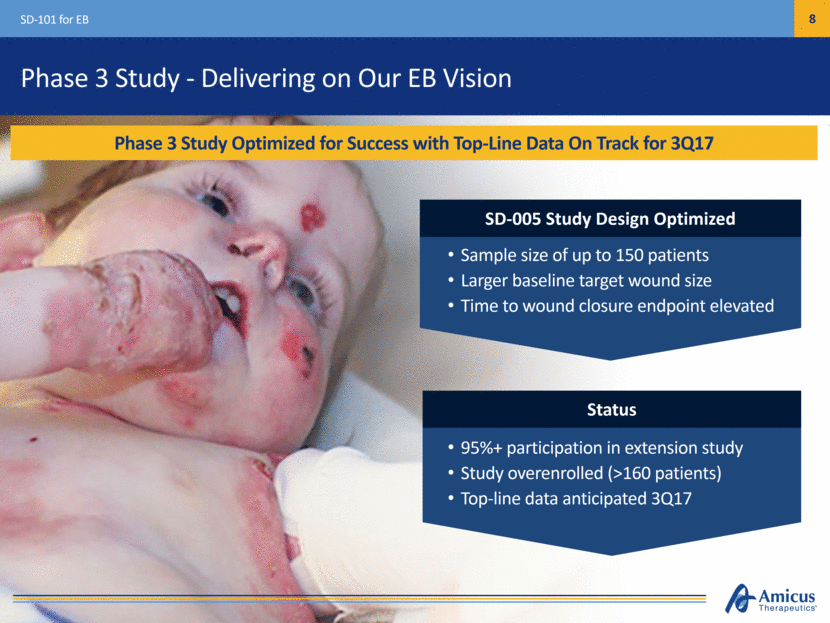
SD-101 Clinical Data Overview
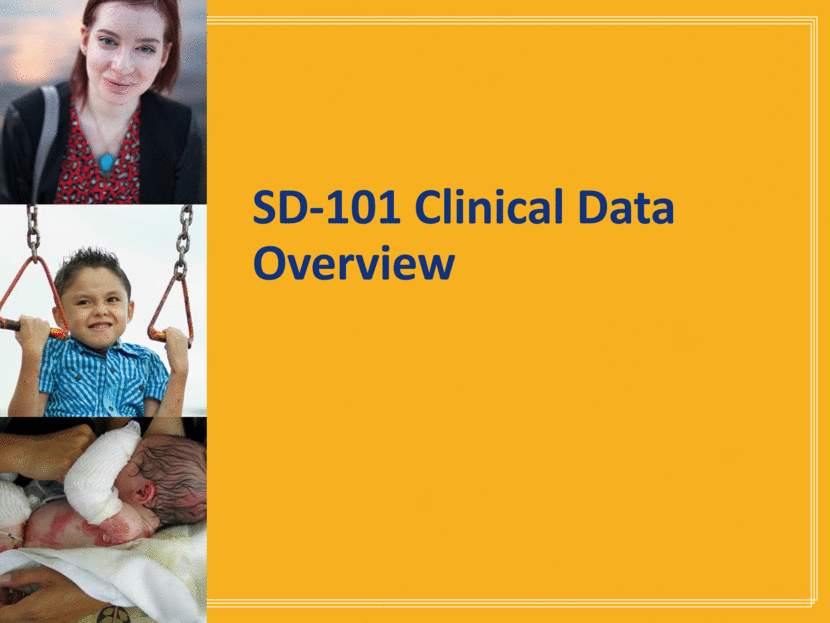
U.S. Breakthrough Therapy Designation Open-label, 8-patient proof of concept study1 Ages 6 months – 9 years All baseline target wounds ≥ 10 cm2 SD-101 3% applied once daily for 3 months SD-101 for EB Positive Early Results from Phase 2a Study Led to Breakthrough Therapy Designation 1. Simplex (n=3), Junctional (n=3), Dystrophic (n=2) Key Findings 1-Year-Old Girl with EB Simplex Baseline Following 2 months of treatment 87.5% of patients experienced complete closure of target wounds within 1 month Daily administration generally safe and well-tolerated 57% reduction in affected body surface area by month 3

Phase 2b Design (Study 003) SD-101 for EB Placebo (n=17) SD-101 6% (n=15) Open-Label SD-101 6% 3-Month, Double-Blind Treatment Period1 Primary Efficacy Endpoint: Target Wound Healing at Month 1 Baseline wound: Chronic (≥ 21 days), size 5-50 cm2 SD-101 3% (n=16) Secondary Efficacy Endpoints Include: Time to target wound closure Change in Body Surface Area (BSA) of lesional skin 42/44 Patients entered extension study $400K FDA Grant for Extension Study 48 EB patients (age ≥ 6 months)1 - 1:1:1 Randomization - Daily Topical Application 1. Assessments: 0, 14, 30, 60, 90 Days. 2. Initial Disease Severity: Mean target lesion size (cm2) 14.0 (range 5-39); mean lesional BSA: 19.4% (range 0.4-48%); mean wound age (days): 182 (range 21-1,639). EB types enrolled: Simplex (n=11), Dystrophic (n=29), and Junctional (n=8) Optional Extension (SD-004)
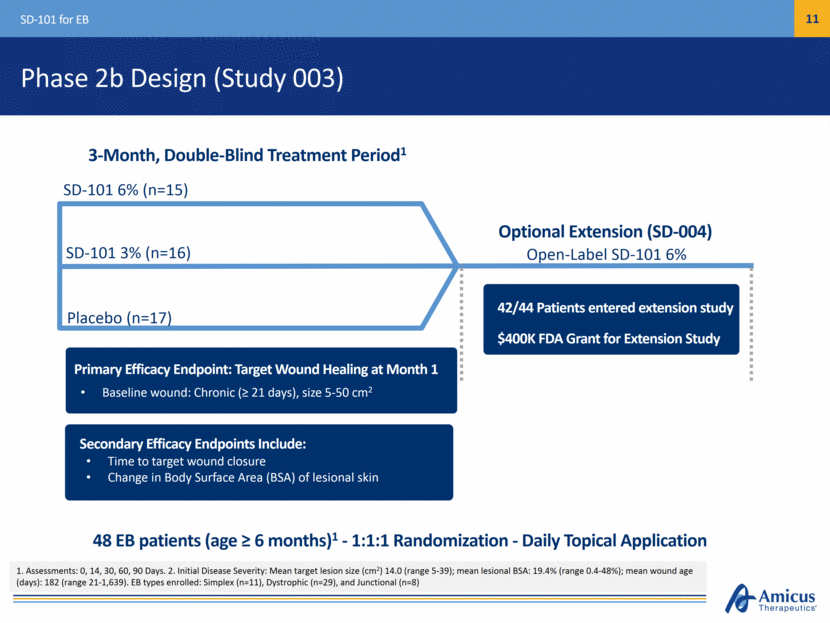
Phase 2b Results SD-101 for EB SD-101 6% Demonstrated Higher Proportion of Complete Target Wound Closure *SD-101 6% vs placebo, unadjusted p=0.04 ITT Population (n=48) Evaluable Population1,2 (n=45) (p=0.04)* Proportion of Complete Target Wound Closure (%) Proportion of Complete Target Wound Closure (%) Excluded from Evaluable population: 1 patient (due to lost to follow-up), 2 patients (did not have single identified and qualified target lesion). 1 additional patient lost to follow up after Month 1 visit and is excluded from target wound assessment at later time points Post-hoc analysis of patients with >10cm2 wounds showed 2/4 (50%) response rate in 6% arm and 1/8 (12.5%) in placebo arm. N=17 N=15 N=16 N=17 N=15 N=16 N=17 N=12 N=16 N=17 N=11 N=16 Placebo SD-101 3% SD-101 6% 41% 41% 38% 44% 67% 82% 41% 41% 38% 44% 53% 60%
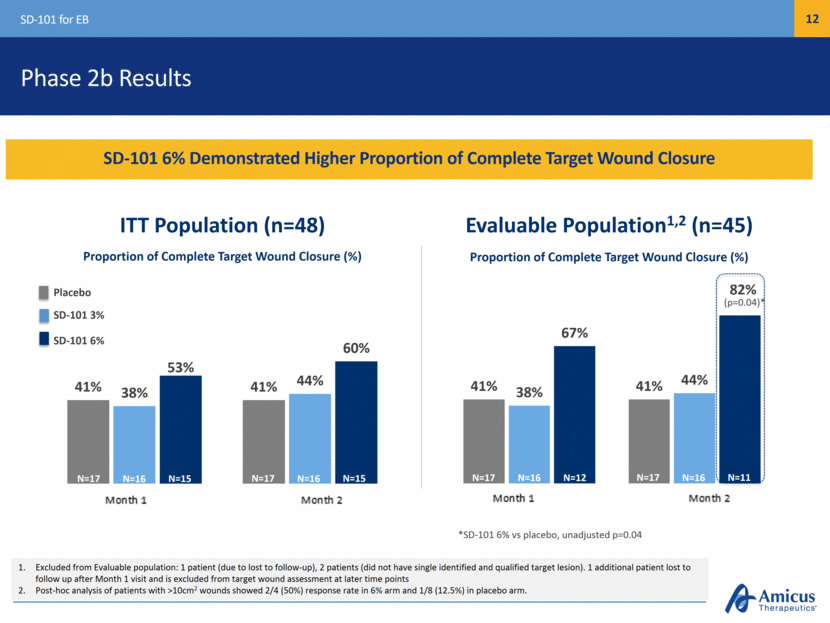
Elevation of Time to Wound Closure Endpoint SD-101 for EB Statistical Analysis Plan (SAP) Near Final to Elevate Time to Wound Closure Endpoint1 Median Time to Wound Closure (Days) Median Time to Wound Closure (Days) 91 Days 86 Days 40 Days ITT Population (n=48) Evaluable Population (n=45) Placebo SD-101 3% SD-101 6% 91 Days 86 Days 30 Days N=17 N=15 N=16 N=17 N=12 N=16 Time to Wound Closure Encouraging results in SD-101 Phase 2b study Measuring healing over time vs. one time point may further control for placebo response Results correlate with incidence of complete wound closure Statistical simulations indicate elevation of time to wound closure increases probability of study success Median Time to Wound Closure in Phase 2b Study 1http://www.fda.gov/downloads/drugs/guidancecomplianceregulatoryinformation/guidances/ucm071324.pdf
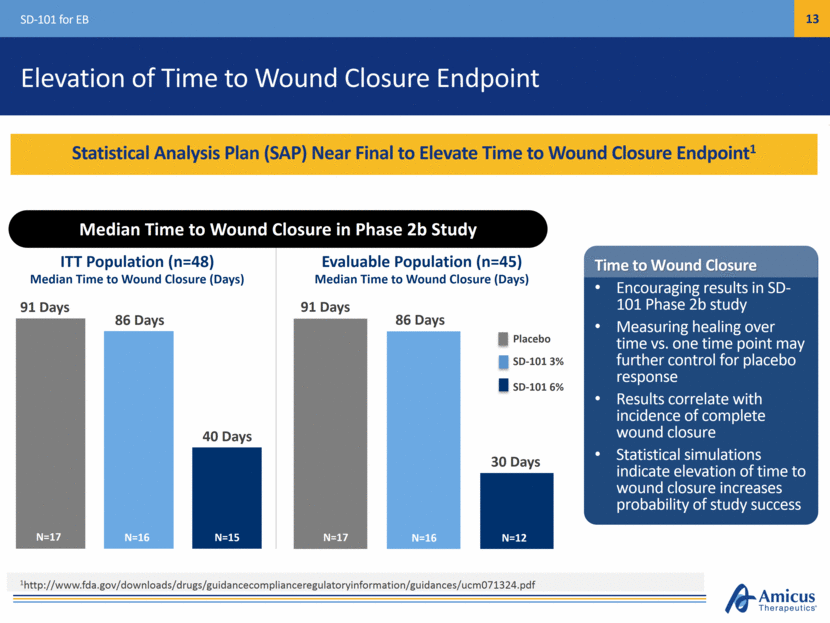
Phase 2b Extension (Study 004) Results SD-101 for EB Results on Total Body Surface Area (BSA) Affected by Wounds and Lesions Mean Absolute Change to Month 12 (95% CI): -3.41% (-7.0, 0.2) BL n=42 M3 n=37 M6 n=33 M9 n=30 M12 n=28 Note: Mean and SEM on change from baseline are plotted. Study 004 Total BSA baseline values are: N=42 Baseline population: 11.3. N=28 population used for Month 12 comparison: 10.9 Mean Relative Change to Month 12 (95% CI): -12.92% (-37.8, 11.9) 3 6 9 12 -5 -4 -3 -2 -1 0 1 2 3 Baseline Time, Months C h a n g e i n T o t a l B S A f r o m B a s e l i n e ( % )
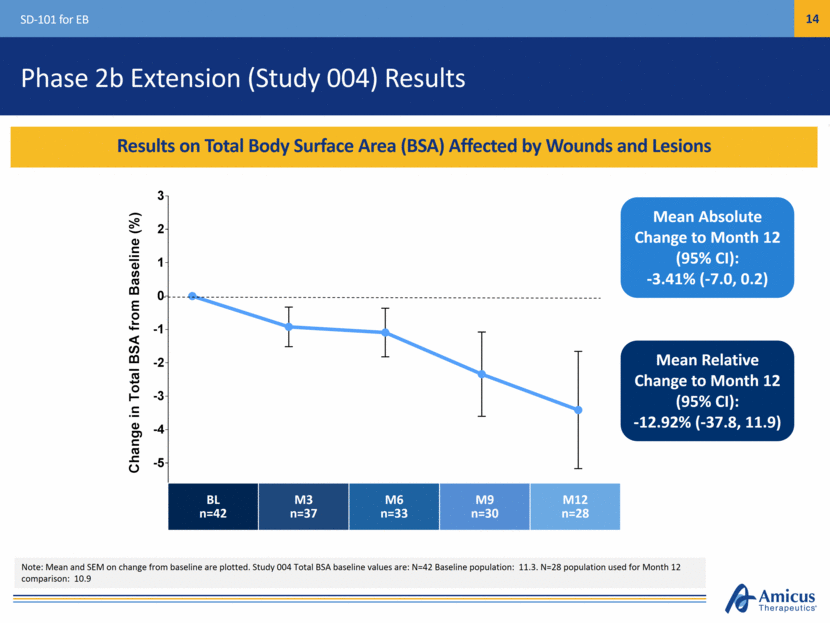
Phase 3 ESSENCE Study Design (SD-005) SD-101 for EB Study Design Optimized for Success >160 EB patients enrolled (age ≥ 1 month) Baseline wound: Chronic (≥ 21 days), size ≥10 cm2 Placebo SD-101 6% Primary Endpoint: Target Wound Healing at Month 2 US and EU regulatory authorities agreed on primary endpoint Baseline wound: Chronic (≥ 21 days), size ≥10 cm2 Primary Endpoint: Target Wound Healing at Month 2 US and EU regulatory authorities agreed on primary endpoint Baseline wound: Chronic (≥ 21 days), size ≥10 cm2 Proposed Endpoints Time to target wound closure (elevated from secondary endpoint) Complete closure of target wound Secondary Endpoints Include: Change in Body Surface Area (BSA) of lesions and blisters Patient-reported itching Patient-reported pain 3-Month, Double-Blind Treatment Period Open-Label SD-101 6% Optional Extension (SD-006) >95% Participation in Extension Study (March 31, 2017) Average Baseline Target Wound Size in Phase 3 Population: ~20 cm2 (March 31, 2017)
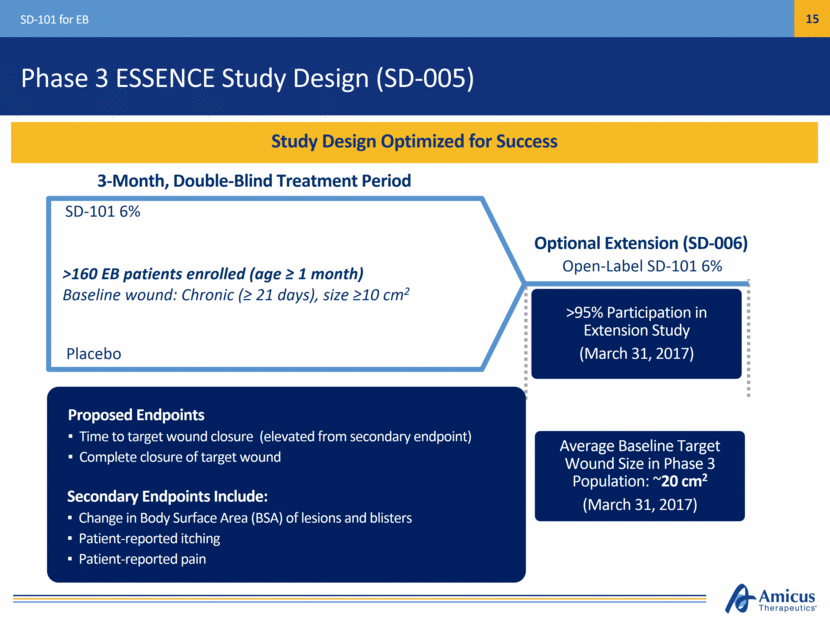
[LOGO]

